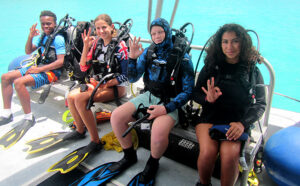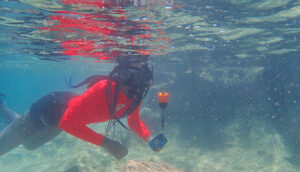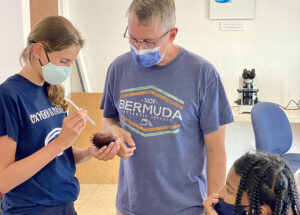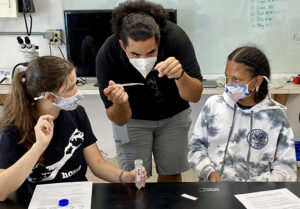New Explorations Abound for BIOS Ocean Science Camp

Now in its third year, the BIOS Ocean Science Camp took place this July over two weeklong sessions. Designed for students aged 12 to 15 who are interested in Bermuda’s marine environments but haven’t gotten the opportunity to study marine science, the popular program provides a variety of activities that introduce participants to the foundations of scientific exploration through the lens of Bermuda’s unique island ecosystems. For many students, the highlight of the camp came on the last day of the week, when they learned the basics of SCUBA diving and took their first breaths underwater in a “Discover SCUBA Diving” experience.
For two sessions this summer (July 19 to 23 and July 26 to 28), 19 students aged 12 to 15 got to experience Bermuda’s marine environments and learn the foundations of scientific investigations through BIOS’s Ocean Science Camp. Now in its third year, the camp is designed for students who are interested in the ocean, but may not have had previous opportunities to study marine science.
The popular weeklong program runs from 9:00am to 4:30pm each day and engages participates in a wide range of activities, including fish and coral identification sessions in the lab, tours of BIOS research facilities, guest lectures from visiting scientists, snorkel trips, and laboratory investigations.

Each day of the camp included a snorkel trip to a different location around the island, allowing students the chance to see and learn first-hand about a variety of marine environments. Students also took pictures of the organisms they saw underwater and spent time reviewing the photos and learning more about the flora and fauna when they returned to the lab back at BIOS. Alay Burgess-Rocker, 14, with camera in hand, explores the waters of Whalebone Bay during a snorkel excursion.
“The program brings together a diverse group of students to explore the ocean, conduct their own scientific experiments, and connect with a wide range of scientists,” said BIOS science education officer Claire Fox. “For some of the students, this was their first time at BIOS, while others had participated in a Curriculum Enrichment Program with their school or joined us for The Bermuda Mission: Camp ROV last month.”
Each day included a snorkel excursion to a different location around the island, giving students the opportunity to explore a wide range of habitats and photograph the organisms living within them. Upon returning to BIOS, the class review their photos, log the organisms they observed, and categorize each organism by taxonomic phyla (ex: Porifera, or sponges; Cnidaria, or corals and sea anemones; Mollusca, or mollusks and snails).

Students also had the opportunity to hear from visiting scientists about their current and ongoing research projects. Justin McAlister, a biology professor at College of the Holy Cross, gave a lecture on invertebrate larvae and led students in a lab on sea urchin spawning. Charlotte Esperon injects a sea urchin with potassium chloride under the guidance of McAlister during the hands-on lab while Azari Lema looks on.
The last boat excursion of each camp session was a “Discover SCUBA Diving” experience. Students learned the essentials of SCUBA theory from BIOS dive safety officer Kyla Smith before heading out on a boat to Whalebone Bay, on the east end of the island. Here, in the sheltered waters along Bermuda’s North Shore, they took their first breaths underwater—a sneak peek of what awaits them if they continue their journey in the BIOS Ocean Academy suite of programs.
“Having the opportunity to take these young aspiring marine scientists SCUBA diving for the first time brings me so much joy,” Smith said. “Being able to witness their first breaths underwater and knowing I helped ignite a deeper more powerful connection and appreciation for our ocean habitat is why I love this job. Experiences like these are crucial stepping stones towards future careers in ocean sciences.”
This year, Ocean Science Camp students also got to learn about the fundamentals of scientific investigations from visiting scientists. Justin McAlister, a biology professor at College of the Holy Cross, gave a lecture on invertebrate larvae and led students in a hands-on lab on sea urchin spawning, where they were able to collect and fertilize sea urchin eggs. Later in the week, doctoral candidate Sebastian Singleton from Oregon State University, led a lecture and a lab on the topic, “What are microbes and how do we study them?”

Doctoral candidate Sebastian Singleton from Oregon State University, who is spending the summer working in the BIOS Microbial Ecology Laboratory, led students in a hands-on lab on the topic, “What are microbes and how do we study them?” Elyse Dej (left) and Mahy Straw (right) watch Singleton prepare a slide to view microplastics.
Students also worked collaboratively on a long-term investigation over the course of the camps, looking at the feeding habits of a local nudibranch, or sea slug. These projects gave them the opportunity to work through many aspects of “real world” scientific studies, including developing a hypothesis, planning the experiment, recording data on a daily basis, and making a conclusion based on their final data analysis.
After the camp, students reported feeling more confident in their snorkeling and marine species identification abilities, as well as their confidence using field guides. Many, like Catrina Furtado, 14, felt “more comfortable in the ocean” after participating in the week’s activities. For others, like Esi Naylor, 14, the experience offered her the chance to “expand my knowledge on plants and animals around Bermuda’s waters.” When asked what she liked best about the experience she said, “I loved meeting new people, snorkeling, and trying SCUBA diving.”
“I was impressed to see the students work so well together during the program and learn from each other,” Fox said. “This was especially evident each morning when they collected data for their nudibranch experiment. They really took ownership of the project and were excited to analyze the results. Seeing the students bonding and learning alongside each other is one of the most rewarding parts of the program.”
